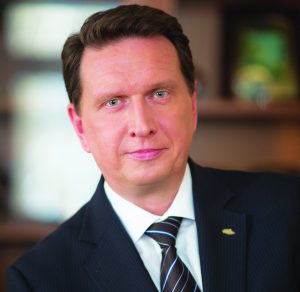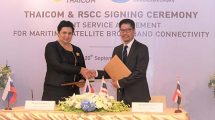 What are the main landmarks in the history of the RSCC?
What are the main landmarks in the history of the RSCC?
In November 1967, the first satellite network of the Orbita system was launched in the Soviet Union to deliver Central Television programmes from Moscow to Siberia, the Far East and Central Asia. In 1968, the Space Communications Station was set up, whose tasks included the operation and development of ground-based satellite communications equipment, the provision of Central TV programmes and telephone communication channels via satellites. Over the next 50 years, the Space Communication Station has grown into a full-fledged operator – the RSCC – which today is one of the largest satellite operators in the world.
With each new generation of satellites, from Molniya (‘Lightning’), Ekran (‘Screen’) and Gorizont (‘Horizon’) to Express (A through AM to the most recent AMU), RSCC capability has kept growing, and its services list expanding.
An important milestone for RSCC was arranging satellite-supported television broadcasts of the Moscow Summer Olympics in 1980. To address the task, a Space Communications Centre (SCC) was set up in Dubna in the Moscow region, which remains the largest teleport in Russia and Eastern Europe.
Having built its own VSAT network in 2009, the RSCC started to actively pursue services based on VSAT technologies – data transmission and the internet – and communications and broadcasting services on sea vessels, including in the Arctic region.
In 2015, we pioneered Ka-band satellite services in Russia, a totally new market in the country. Today, the length of the RSCC satellite network in Ka-band is 7,000km, arguably the longest satellite network in the world.
Over the past five decades, the company has transformed from a small teleport and a pioneer in the field of television broadcasting via an HEO satellite to a successful geostationary satellite operator with a presence in 52 countries and an integral part of the global satellite communications industry.
What have been the key achievements of RSCC over these 50 years?
I think the main result of our work is user satisfaction. From a satellite communication station whose tasks were strictly confined to just operating the facilities, the RSCC has developed into a full-fledged all-around operator. The enterprise survived and kept on developing in the period of the country’s political system change and deep economic crisis. We also experienced a painful period of spacecraft failures in orbit and losses of satellites at launch. Today, the RSCC successfully operates in a highly competitive environment.
We have managed to become an operator which is convenient to work with. Having staged a management revolution, we have developed into a client-oriented company that successfully competes with the world’s satellite business big four. In today’s open market, the Russian consumer and service providers in most cases choose RSCC services: 80% of Russian users work via domestic operators. At present, our spacecraft are highly competitive on the global market.
What can you tell us about the RSCC’s satellites and market presence?
The RSCC fleet currently includes twelve spacecraft in the geostationary orbit, located from 14° W to 145° E and covering the territories of Russia and CIS, Europe, the Middle East, Africa, Latin and South America, Asia and Australia. The RSCC satellite constellation includes multi-functional spacecraft of the Express-AM, Express-AMU and Express-A series, as well as the direct broadcast satellites Express-AT.
The harmonious combination of various orbital positions, the frequency bands, fixed and narrow beams with cross-strapping options, vertical applications and geographic areas, as well as a network of regional partners and teleports – all this offers a unique opportunity to provide communications and broadcasting services almost all over the globe.
The RSCC never stops to update its orbital constellation. In the period from 2013 to 2015, seven new satellites were successfully launched, and now the RSCC operates one of the youngest fleets, in which an average in-service period of a satellite does not exceed five years. This is highly appreciated by customers: they can sign long-term contracts with the confidence that they will not have to change the satellite in the near future.
The company also uses the most progressive solutions when ordering its satellites, including electric propulsion systems, high throughput Ka-band, frequency reuse and so on. Also, the RSCC operates five world-class teleports, providing two-way satellite communications, tracking, telemetry and monitoring for other satellite operators.
What is the company strategy, and what kind of services do you aim to provide?
Initially, the goal of the company was to satisfy the needs of Russian customers, but then RSCC began to offer international satellite capacity to domestic customers, subsequently turning into an international commercial operator. Today, about 40% of the company’s revenues come from international sales. The RSCC is one of the key players in the Middle East market, providing support to its regional and European customers. In addition, the RSCC successfully operates in North and sub-equatorial Africa, South Asia and Latin America. In the international market, the company offers unique solutions to connect Europe, North Africa, the Middle East and southern Asia.
Long-term relations with our customers and flexibility in meeting their needs are the hallmark of the RSCC, which helps in making attractive market-based optimised price-versus-quality offers to customers.
From leasing the satellite segment, today we are proceeding to tackle complicated solutions and services, including corporate networks, mobile communications, massive broadband access and the company’s proprietary television platform.
What are the main challenges facing the RSCC?
We see our main task as fully satisfying the needs of our customers. The deficit of satellite capacity in Russia which existed five years ago was overcome by bringing into orbit seven new RSCC satellites in the period from 2013 to 2015. The company’s activities are now shifting to the area of providing value-added services based on complex combined solutions. New opportunities appear in the market at the interface of IT and communications. The future, in our opinion, belongs to the convergence of services. The social goals and rapidly changing needs of users are acquiring particular relevance. We plan to work in all geographically accessible markets, while continuing to develop vertically.
What are your plans for capital expenditure to build new satellites?
Until 2025, the RSCC plans to build, launch and commission five spacecraft for geostationary orbit and four spacecraft in high-elliptical orbits, and we also plan to further develop the ground infrastructure. The orbital frequency resource available for use in satellite communication networks will see a 1.7-fold increase. Two satellites – Express-103 and Express-80 – are already in production.
The development of the constellation will ensure the creation of a promising information and telecommunications infrastructure that will enable us to address tasks in the interests of economic development, public administration and security throughout the Russian Federation, including the Arctic zone, and to increase the RSCC presence in the international market.
What services does the RSCC primarily plan to develop?
In the past few years, the RSCC has made significant investments in the ground infrastructure of satellite networks, allowing us to enter new market segments where previously we had no presence. Last year, the RSCC fully commissioned its own network of high-speed satellite broadband internet access in the Ka-band. We have changed our approach to the provision of television services. Where originally we provided primarily satellite capacity to large pay-TV operators, we now rely on our own RSCC television platform to provide a comprehensive service to broadcasters in a single-window mode.
Another promising area has been the development of broadband access for mobile objects. Currently, we provide services for sea vessels in the Atlantic, Arctic and Pacific oceans, including access to the internet, reception of television programmes, video surveillance, weather data transmission and telephone communications.
In its Development Strategy, RSCC concentrates on several high-tech areas which in the near future will undoubtedly have an impact on the structure of the satellite communications market in the face of growing market competition.
They are:
a) implementation of new projects involving new spacecraft in both the geostationary and highly elliptical orbit (HEO) to address priority tasks of fixed and mobile satellite communications for government and commercial customers in Russia, including the Arctic region;
b) adaptation of the existing space and ground infrastructure of the company to handle new tasks of providing communication of mobile objects and the developing market of large data, including the Internet of Things.
What does the RSCC expect to achieve by the end of 2017, and in the next five years?
Last year, when earnings of most international satellite operators were plummeting, the RSCC demonstrated good revenue growth, which in rubles increased by 24%. The main task of the RSCC until the end of 2017 is to maintain business growth and meet the planned revenue targets in the conditions of industry stagnation.
The entire satellite communication industry is going through a difficult period. The offer of satellite capacity considerably exceeds demand, competition of satellite operators against FOL is getting tougher, and new national operators are emerging, complete with their own space vehicles. In these circumstances, it is essential that we retain the current client base, primarily in the home region, and that we support organic development and access new geographical and vertical markets. Particular emphasis should be placed on increasing the share of high-margin services, such as maritime VSAT. For example, the RSCC is developing its communication and broadcasting services along the Northern Sea Route, which is becoming an increasingly busy area of navigation. To advance communications in the Arctic, in addition to GEO satellites, we plan to use spacecraft in the HEO.











Add Comment